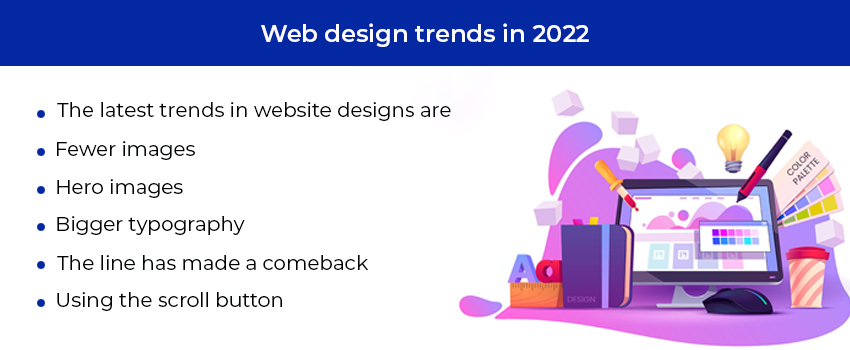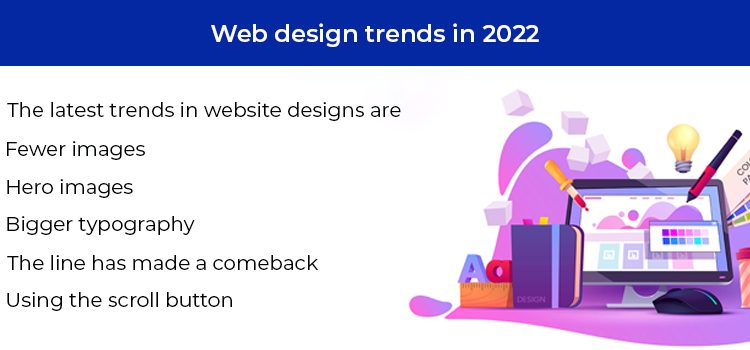Web Design Trends in 2022
The art of web designing is focused on catching the attention of users and encouraging them to spend more time on websites. The focus for web designers is, therefore, to come up with new designs that are unique and creative. Designers are constantly on the lookout for new ideas that can captivate the audience, and to that effect, they often play with various elements in a webpage to identify styles that are successful in retaining users.

Web designing has come a long way from the days when designers had limited tools and resources to build pages. New-age websites use many technologies and designers have a plethora of tools at their disposal to develop unique sites. They have more choices these days to manipulate content more effectively. With the focus on interactivity, the focus has been on websites that can interact more with users. Dynamism has become the catchword and sites that do not change to suit changing requirements of customers tend to fall behind.
But is it going to affect you?
The latest trends in website designs are:
Focus on simplicity
The focus of website designers in the New Year is to keep things simple and short, thus giving rise to the much-seen, one-page website design. A simple website is not technically challenged; its content is however kept to the minimum. The focus is more on directing content as per the users’ requirements than serving content on a platter. Such websites have seen the use of fewer menus while navigation is kept simple. When designers make a one-page website, they have to think hard about what they need to highlight, rather than how much to highlight. This reduces distraction for users and gives the impression that sites have been built to a choice.
Fewer images
Designers seem to be bringing their scissors to images when it comes to web designing. No more are huge images entertained and the focus is now on using simple shapes and colours combined with typography and layout to focus on the content at hand. This is again, a measure aimed at reducing distraction and enhancing the effectiveness of the website.
Hero Images
Hero images or hero sections are the first part of a website that users see. Such a section needs to be impactful and carry an influential message. Hero sections use text rather than images to drive home a point. They are like punch lines that companies use in advertisements and convey the message that the firm would like to highlight about itself. Designers revel in hero sections because it provides them with enough space to put up some creative text and matter with some intelligent mix-and-match strategies.
Bigger Typography
Designers these days seem to be experimenting with typography as a tool to measure the effectiveness of content. What you get to see these days are bigger texts that seem to make a bigger impact on users. Designers are not averse to playing with font size and colours to create effects with text. Such use of text is mostly seen in websites that focus on a particular individual, a product or a portfolio.
The line has made a comeback
While the lack of obvious lines made a good design style statement some time ago, it seems lines have come back with a vengeance! Website designers are more focused these days on maintaining order and segregation on their pages so that viewers can be taken from one section to another in an orderly manner. The use of JavaScript and CSS significantly enhances the use of lines to highlight, direct and focus on content as per the needs of the customer.
Retro designs
Another trend that is fast catching up is retro designs. Many designers are now turning to designs of the 80s and 90s that feature bright colours, borders and prominent table layouts. The idea is to often create a nostalgic feel for customers. Such sites not only become unique but also can be used to appeal to the emotional side of customers when they visit the site.
Using the scroll button
Scrolling is perhaps the most used action by a visitor on a webpage. Many designers consider this an opportunity to make the website more interactive for the visitor. While experienced web designers would use it to deliver compelling content for users, some might decide to use it minimally.


